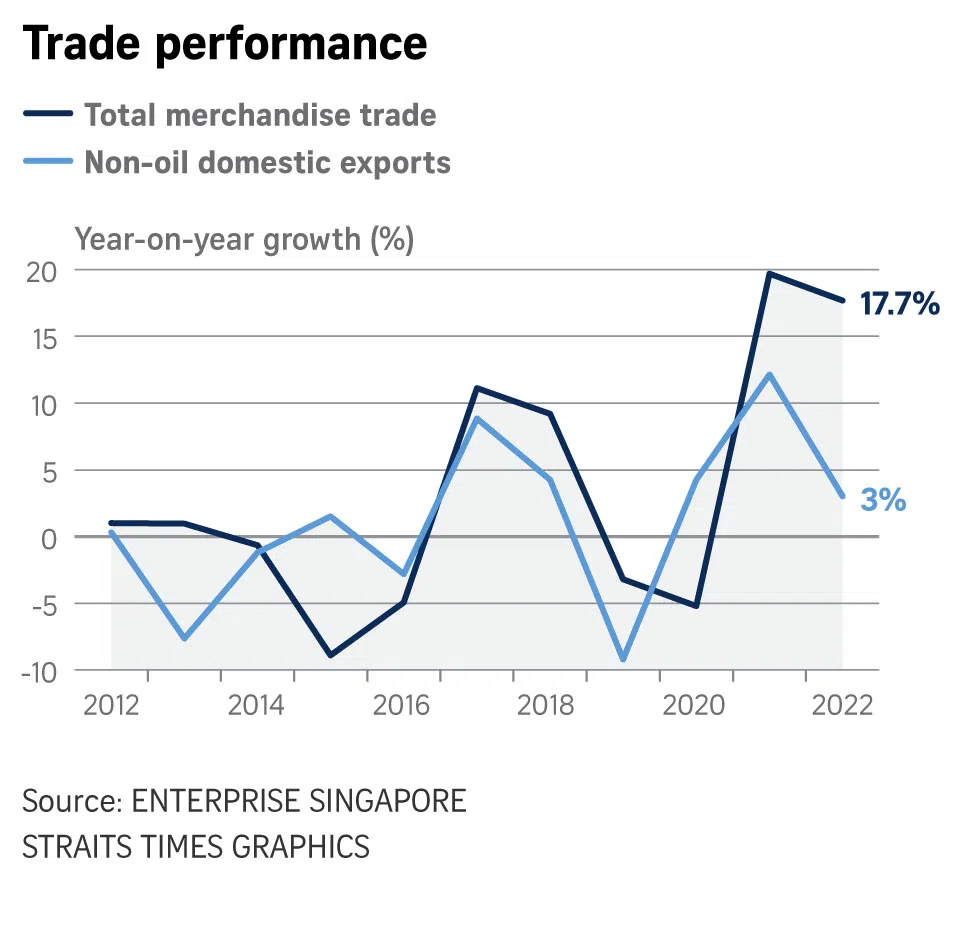Singapore exports forecast to shrink or stay flat in 2023 as growth slows to 3% last year
Sign up now: Get ST's newsletters delivered to your inbox

EnterpriseSG said the pace of Nodx growth had eased in 2022, “partly reflecting weakened global semiconductor demand and global economic activity”.
PHOTO: ST FILE
Follow topic:
SINGAPORE – Singapore’s key non-oil domestic exports (Nodx), and total merchandise trade, which includes oil, are expected to post minus 2 per cent to 0 per cent growth in 2023, Enterprise Singapore (EnterpriseSG) said on Monday, maintaining its earlier forecast.
This is as Nodx growth slowed to 3 per cent in 2022 from 12.1 per cent in 2021, with fourth-quarter shipments dropping by a sharp 14 per cent after the third quarter’s 7.1 per cent growth.
Although Singapore’s oil trade grew by 47.5 per cent in 2022 as oil prices soared in the wake of the Russia-Ukraine war, prices are expected to ease in 2023.
For the fourth quarter, under-pressure electronic exports contracted by 15.9 per cent, accelerating from the previous quarter’s 1.8 per cent decline.
Non-electronic exports dropped by 13.4 per cent in the fourth quarter, reversing the 10 per cent rise in the third quarter.
EnterpriseSG said the pace of Nodx growth had eased in 2022, “partly reflecting weakened global semiconductor demand and global economic activity”.
Mr Shivaan Tandon, emerging Asia economist for research firm Capital Economics, said the downturn in the electronics sector has led to an excess supply of electronics across various manufacturing hubs, including Singapore.
“Various electronics companies at home and abroad are shelving plans for capacity expansion,” he added.
For 2023, Singapore’s total trade and Nodx are expected to moderate from the high base in 2022, given the darker global economic and trade outlook, EnterpriseSG said.
Citing International Monetary Fund projections that global economic activity will grow by a slower 2.9 per cent in 2023, EnterpriseSG said: “Most of Singapore’s key trade partners, including the United States, euro zone and Asean-5, are expected to grow at a slower pace in 2023, except China and Japan.”
Mr Tandon said that while an acceleration in China’s economic growth is a positive, significantly weaker performance in the US and euro zone will weigh on the trade outlook.
He added that elevated interest rates will curb firms’ appetite to expand capacity and therefore reduce demand for capital goods exports, “which account for the lion’s share of Singapore’s goods exports”.
The World Trade Organisation has projected “subdued” global merchandise trade, with growth slowing to 1 per cent from 2022’s estimated 3.5 per cent.
“Headwinds in the global economy, including the war in Ukraine, inflation and monetary tightening, could weigh on global trade and output,” said EnterpriseSG.
The agency said that the lower oil prices expected in 2023 could weigh on Singapore’s oil trade, while moderating global demand for semiconductors could drag down electronics trade.
Higher oil prices in 2022 boosted Singapore’s oil trade, which surged 47.5 per cent, following the 43.6 per cent jump in 2021.
Non-oil trade grew 11.9 per cent, slowing from the 15.9 per cent increase in 2021.
Total merchandise trade, which includes total exports and total imports, grew 17.7 per cent to $1.4 trillion.
That marks a slowdown from the 19.7 per cent growth recorded in 2021, but is still a better performance than in 2020, when total merchandise trade fell by 5.2 per cent.
Singapore is one of the most export-driven economies in the world, with an exports to gross domestic product ratio of about 180 per cent, said Mr Tandon.
“Therefore, external demand plays an outsized role in shaping Singapore’s growth trajectory,” he added.



